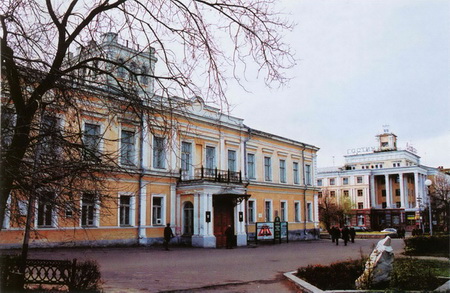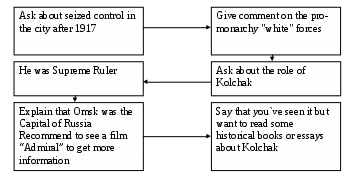Учебное пособие по разговорному английскому языку для студентов всех специальностей неязыкового вуза
 Скачать 4.24 Mb. Скачать 4.24 Mb.
|
nomad – кочевникoriginal – первоначальныйjail - тюрьмаdenomination - конфессияmansion – дворецrecede – отступать, удаляться13. Read the words and their explanations |
| Dates | Places | Rivers | Buildings |
| | | | |
| | | | |
| | | | |
Vocabulary Training
19. Read and remember the following words and word combinations
merchant – купец
flock – стекаться, собираться
junction – место пересечения, соединения
elaborate - тщательно, детально разработанный, продуманный
hustle-and-bustle – энергично развивающийся, передовой
pinnacle - вершина
20. Skim the text below and say that in English
транс-сибирская железная дорога, место пересечения рек и дорог, иностранные державы, огромная выставка, вершина успеха, сибирский Чикаго
Reading

21. Scan the text quickly.

The new boom
T
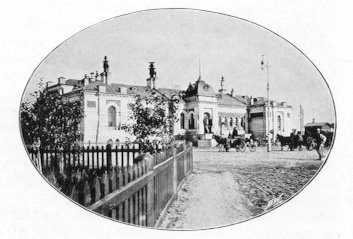 he new boom began with the construction of the Trans-Siberian railway in 1890s, when the merchants flocked to the city on the rail-and-river junction. Many trade companies opened stores and offices here. They built an elaborately decorated district of the city and brought the hustle-and-bustle of modern transportation, means of communications and entertainment here. Foreign powers, including the British, Dutch and Germans, opened consulates to represent their commercial interests. The pinnacle of success came to Omsk with the lavish Siberian Exposition of Agriculture and Industry in 1910. For this Exposition a complex of buildings and fountains was constructed. The constructions as well as the “wonders” of that Exposition influenced the observers greatly so Omsk was called as "Chicago of Siberia".
he new boom began with the construction of the Trans-Siberian railway in 1890s, when the merchants flocked to the city on the rail-and-river junction. Many trade companies opened stores and offices here. They built an elaborately decorated district of the city and brought the hustle-and-bustle of modern transportation, means of communications and entertainment here. Foreign powers, including the British, Dutch and Germans, opened consulates to represent their commercial interests. The pinnacle of success came to Omsk with the lavish Siberian Exposition of Agriculture and Industry in 1910. For this Exposition a complex of buildings and fountains was constructed. The constructions as well as the “wonders” of that Exposition influenced the observers greatly so Omsk was called as "Chicago of Siberia". 22. Read the statements and say whether they are true or false
1. The new depression began with the construction of the Trans-Siberian railway.
2. The merchants flocked to the city to hide out from the gendarmes.
3. Trade companies built an elegant district of the city.
4. Foreign Governments opened consulates in Omsk to represent their commercial interests.
5. By 1910 a complex of buildings and fountains had been constructed.
23. Give answers to the questions below.
1. What was the new boom of Omsk connected with?
2. What modern achievements of those days were there in Omsk?
3. What was called as the pinnacle of success?
4. Why was Omsk called as "Chicago of Siberia"?
Vocabulary Training
24. Read the following words and word combinations.


shortly after, pro-monarchy, forces, Provisional Government of Russia, decorated war hero, Imperial gold reserves,
25. Remember the following words and word combinations
key to power – островок власти
eventually – в конечном счете
retreat - отступить
seize - захватить
Reading_32._Read_the_text_about_the_Soviet_period_in_the_history_of_Omsk'>Reading
26. Read the text quickly.


“White” period
Shortly after the 1917 revolution, the pro-monarchy "white" forces seized control of the city. The "Provisional Government of Russia" was established in 1918, headed by the polar explorer and decorated war hero Admiral Kolchak. He was n
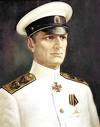 amed Supreme Ruler (Verkhovnyi Pravitel). And Omsk was proclaimed the Capital of Russia, and its central bank kept the Imperial gold reserves. The city proved to be a key to power in Siberia. Eventually, Kolchak, the government, and the gold retreated along the Trans-Siberian eastward to Irkutsk, and the bolshevik "red" forces took control in 1919.
amed Supreme Ruler (Verkhovnyi Pravitel). And Omsk was proclaimed the Capital of Russia, and its central bank kept the Imperial gold reserves. The city proved to be a key to power in Siberia. Eventually, Kolchak, the government, and the gold retreated along the Trans-Siberian eastward to Irkutsk, and the bolshevik "red" forces took control in 1919.27. Answer the questions to the text above.
1. Who headed the “Provisional Government of Russia”?
2. When was Omsk proclaimed as the Capital of Russia?
3. What year was the control taken by the “red” forces?
Speech practice
28. Work with your partner.


Partner A Partner B
Vocabulary Training
29. Remember the following words and word combinations
designate – номинировать, провозглашатьprompt – побуждать, вызыватьdampen –ослаблять, останавливатьspark – вспыхивать, искрить | rival – конкурентboost – подъемto be responsible for – (зд.) быть инициатором, автором |
30. Translate the words given below.
soviet era, provisional, capital, military, industry, victory
31. Look through he abbreviated names of design sections or bureas and match them with the full variants and the comments
1. OKMO | 1. Omsk Transmash design bureau | 1. metallurgy and heavy machine-building bureau |
2. KBTM | 2. Experimental Design Mechanical Section | 2. the main tank design team in the Soviet Union during the early 1930s. |
Reading
32. Read the text about the Soviet period in the history of Omsk
Soviet era
T
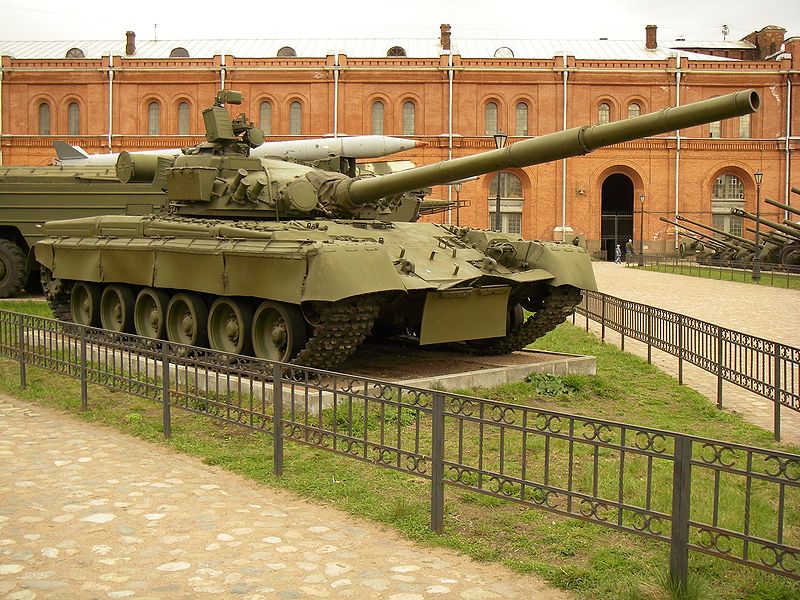 he Soviet government preferred young Novonikolayevsk, now Novosibirsk, to be the designated centre of Western Siberia. It prompted the mass transfer of administrative, cultural and educational functions from Omsk. The city's growth dampened. Sparking rivalry between the two cities continues to this day. And it was during and after World War II that Omsk received a new boost. Many industries were evacuated away from the western part of Russia in 1941. In the event of a German victory during the Battle of Moscow, Omsk was to become the provisional Soviet capital. Many military industries moved here including part of the OKMO tank design bureau in 1941.
he Soviet government preferred young Novonikolayevsk, now Novosibirsk, to be the designated centre of Western Siberia. It prompted the mass transfer of administrative, cultural and educational functions from Omsk. The city's growth dampened. Sparking rivalry between the two cities continues to this day. And it was during and after World War II that Omsk received a new boost. Many industries were evacuated away from the western part of Russia in 1941. In the event of a German victory during the Battle of Moscow, Omsk was to become the provisional Soviet capital. Many military industries moved here including part of the OKMO tank design bureau in 1941. S.M. Kirov Factory no. 185 moved from Chelyabinsk in 1962. The Kirov Factory and Omsk Transmash design bureau (KBTM) produced T-80 tanks from the 1970s, and were responsible for the BTR-T, TOS-1, and prototype Black Eagle tank. Omsk Transmash declared bankruptcy in 2002.
33. Answer the following questions.
1. What was the cause of the transfer of administrative functions from Omsk?
2. Why is there a rivalry between two cities?
3. When did Omsk receive a new boost?
4. What is the origin of many industries in Omsk?
34. Work out a plan to the text.
Vocabulary Training
35. Remember the following words and word combinations
to be in full swing – быть в полном разгаре
oil – refining – нефтепереработка
employer -работодатель
36. Guess the meaning of the following words or expressions
northward, currently, parent company, expand
Reading
37. Read this text quickly and define the main idea of this text.
Omsk oil - refining
I
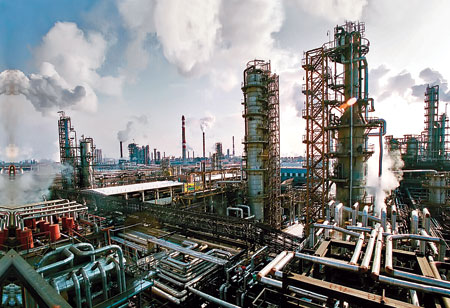 n the 1950s the development of oil and natural gas field in Siberia was in full swing. And an oil-refining complex was built here, along with an entire "town of oilworkers" (gorodok Neftyanikov). So Omsk expanded northward along the Irtysh. It is currently the largest complex in Russia, and third such in Europe. Gazprom Neft, the parent company, is the largest employer in the city.
n the 1950s the development of oil and natural gas field in Siberia was in full swing. And an oil-refining complex was built here, along with an entire "town of oilworkers" (gorodok Neftyanikov). So Omsk expanded northward along the Irtysh. It is currently the largest complex in Russia, and third such in Europe. Gazprom Neft, the parent company, is the largest employer in the city.Vocabulary Training
39. Read and remember the following words and word combinations
| centrepiece - наиболее ценный предмет ensemble - ансамбль flank - быть расположенным сбоку, располагаться по обе стороны chapel – часовня at hand - близко bourse - биржа | stately – величавый mansion – особняк dormition – успение revival – возрождение consecrate – освящaть commission - указание, приказание действовать каким-л. образом edifice - величественное здание, строение |
40. Work with your partner. Match synonyms


junction, adjoining, rich, somber, landmarks, scatter, side, carefully, confluence, building, darksome, opulent, edifice, meticulously, sights, diffuse, cutting edge
Reading
41. Scan the text and express its general idea.
Architecture of Omsk
T
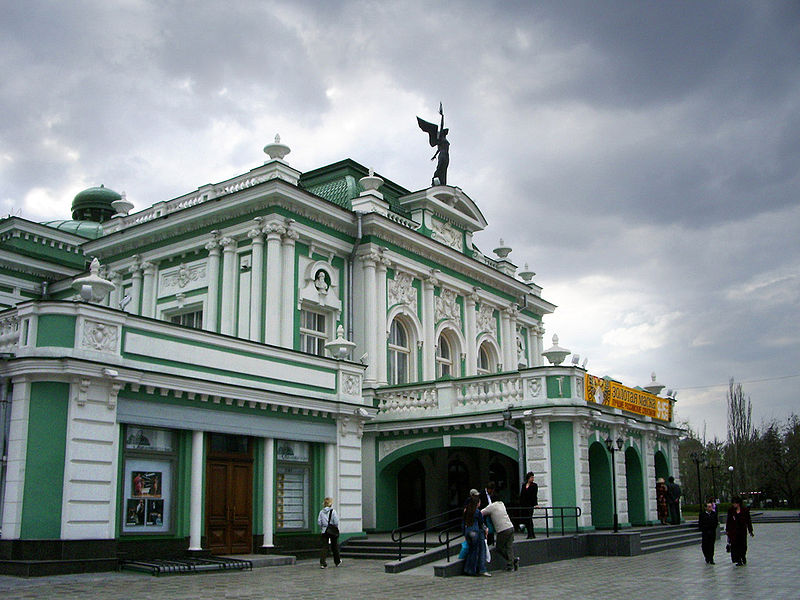 he centrepiece of the city is an ensemble of buildings along Lyubinsky prospekt (Lenin Street). This is the former Gostiny Dvor, flanked by two chapels. Close at hand are a bourse and a Drama theatre. Both buildings are dated from late 1800s – early 1900s. Side streets are lined with stately mansions of former insurance companies, trusts and banks from the same period. Hidden closer to t
he centrepiece of the city is an ensemble of buildings along Lyubinsky prospekt (Lenin Street). This is the former Gostiny Dvor, flanked by two chapels. Close at hand are a bourse and a Drama theatre. Both buildings are dated from late 1800s – early 1900s. Side streets are lined with stately mansions of former insurance companies, trusts and banks from the same period. Hidden closer to t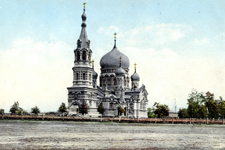 he river confluence are the few surviving somber buildings of the 18th-century fortress. The largest and most opulent church in the city is the Dormition Cathedral, a five-domed edifice in the Russian Revival style. It was consecrated in 1896 but blown up by the Soviets. Fortunately, it was meticulously restored in the early 2000s.
he river confluence are the few surviving somber buildings of the 18th-century fortress. The largest and most opulent church in the city is the Dormition Cathedral, a five-domed edifice in the Russian Revival style. It was consecrated in 1896 but blown up by the Soviets. Fortunately, it was meticulously restored in the early 2000s.A
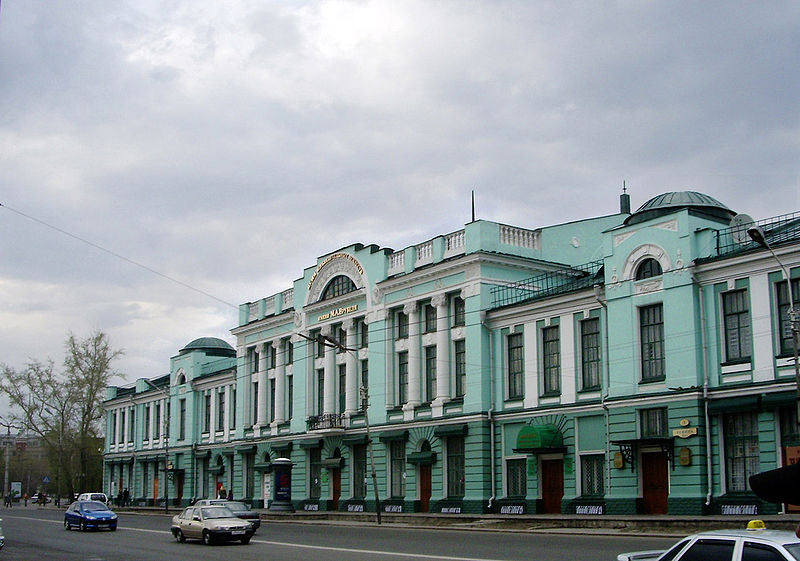 nother area of interest is Nikolsky prospekt (Krasnykh Zor Street), where a line of merchants' wooden houses still stands. The street leads to the Neoclassical cathedral of St. Nicholas. It was commissioned by the Cossacks. It was designed by Vasily Stasov and consecrated in 1840. It contains various relics of the Siberian Cossacks. Various other landmarks are scattered throughout the city.
nother area of interest is Nikolsky prospekt (Krasnykh Zor Street), where a line of merchants' wooden houses still stands. The street leads to the Neoclassical cathedral of St. Nicholas. It was commissioned by the Cossacks. It was designed by Vasily Stasov and consecrated in 1840. It contains various relics of the Siberian Cossacks. Various other landmarks are scattered throughout the city.The major museums in Omsk are the Omsk Vrubel Art Gallery and the State Historical Museum, located in the former bourse building and the governor-general's mansion, respectively.
Among the attractions of city - more than several dozen churches, monuments, including the style of "l’art nouveau", historic sites, and sculptures devoted to famous people, and lots of other interesting places.
One more thing that could easily be referred both to architecture and transportation is a subway system. It was proposed in the late 1980s, but postponed for lack of funds. Currently it is under construction, with the Metro bridge over the Irtysh river. The bridge is already opened for cars (upper level), but the metro (lower level) is still under construction. As a first step one short line will connect the districts in the northwest with the city centre. The first line of the metro is scheduled to be finished in 2010 and generally our subway system is going to be the cutting edge.


 he wooden fort of Omsk was erected in 1716 to protect the expanding Russian frontier, along the
he wooden fort of Omsk was erected in 1716 to protect the expanding Russian frontier, along the  n the 19th and early 20th century, Omsk became the administrative center of Western Siberia and the Steppes (
n the 19th and early 20th century, Omsk became the administrative center of Western Siberia and the Steppes (